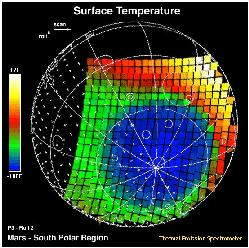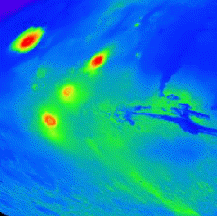This drawing shows a cross-section of the Martian frozen ground.
Click on image for full size
NASA
The Martian Cryosphere
The Martian geography is one of high altitudes at high southern latitudes and low altitudes at low latitudes.
The ground is less frozen at low latitudes because it is warmer and water can evaporate. Thus, at low latitudes (near the equator) the ground is possibly devoid of water to a depth of 200 m, while at high latitudes (corresponding to high altitudes) the ground is devoid of water to a depth of only 1 m. Another way of saying the same thing is that the frozen ground is only 2.5 km deep at the Martian equator while it is 6 km deep at the south pole.
The figure shows a crossection of the crust, and the unusual altitude variation of the Martian surface. The figure illustrates the depth of frozen ground at various latitudes, called the cryosphere, as well as the depth to which the aquifer, or layer of liquid water, may exist across the planet. To have liquid water running on the surface of Mars, the aquifer, or liquid region, must be exposed to the surface. This may have happened at various times in the history of Mars as the climate changed.
You might also be interested in:

This is an image of a storm moving across the Martian terrain. The camera is looking down upon the storm and the storm front forms a spiral pattern, the same way terrestrial storms are presented on the
...more
The unusual global geography of Mars helps to explain the fact that water has been drawn from the southern hemisphere to the northern hemisphere of the planet through all of Martian history (that is, from
...more
This image shows how cold the surface of Mars can be. The temperature data is from the Mars Global Surveyor mission. The scale to the left shows that purple regions are the coldest, about -170 degrees
...more
On this map of Mars, the lightly cratered Tharsis Ridge is shown, as well as the heavily cratered Martian highlands (near the bottom of the picture), and Valles Marineris to the right. The volcanoes are
...more
The Martian geography is one of high altitudes at high southern latitudes and low altitudes at low latitudes. The ground is less frozen at low latitudes because it is warmer and water can evaporate. Thus,
...more
Separate from the Martian outflow channels, or the river valley networks, are large Martian lakes (600 km, or ~1000 miles across) which exhibit evidence of a periodic and catastrophic release of water
...more
This is an image of fog in a Martian canyon. The presence of fog provides evidence of water, and a water cycle on Mars. More fog has been seen in images returned by Mars Global Surveyor of the south polar
...more
The Martian climate is more influenced by the shape of the Martian orbit than the climate of the Earth is influenced by the shape of the Earth's orbit. The orbit of Mars is more elliptical than that of
...more













